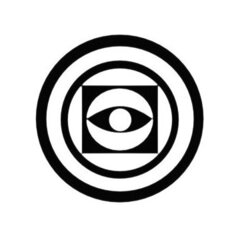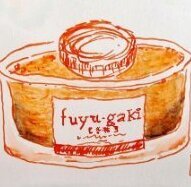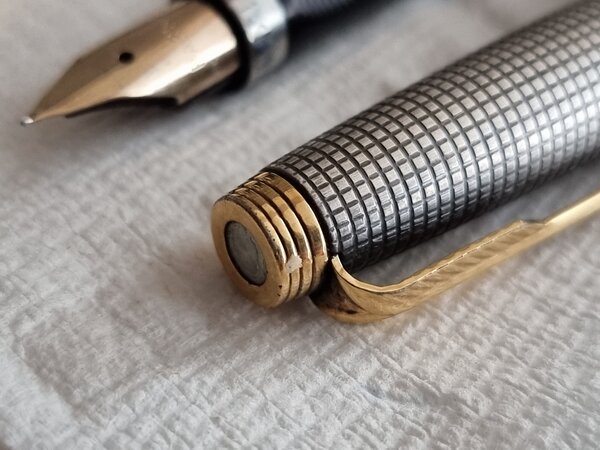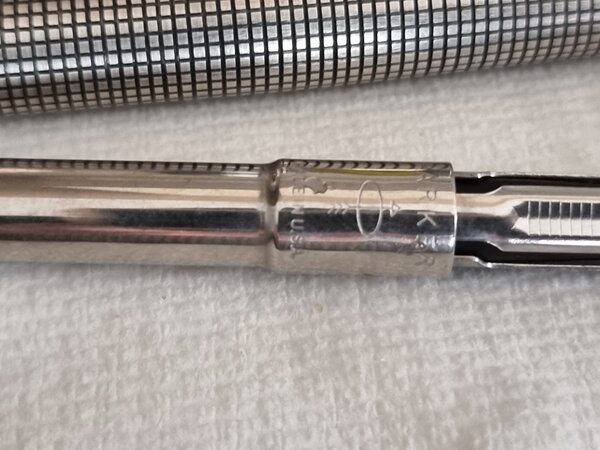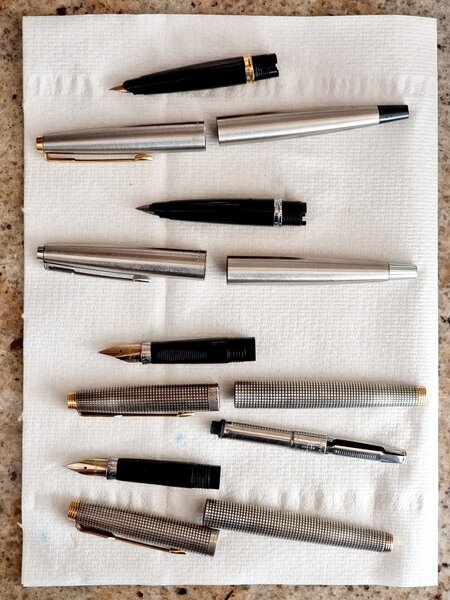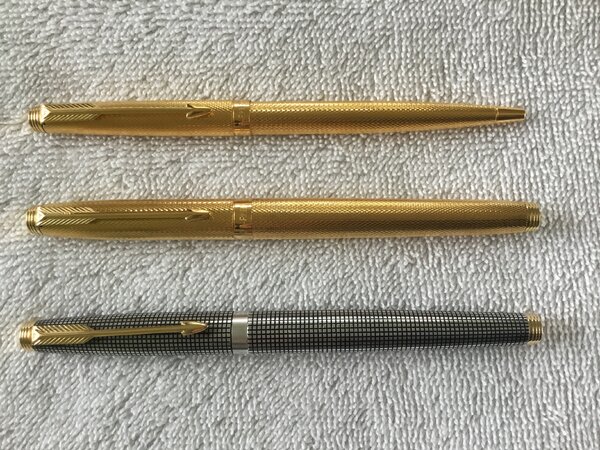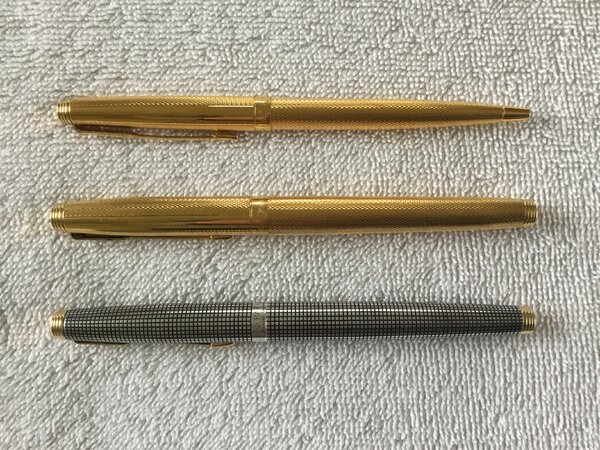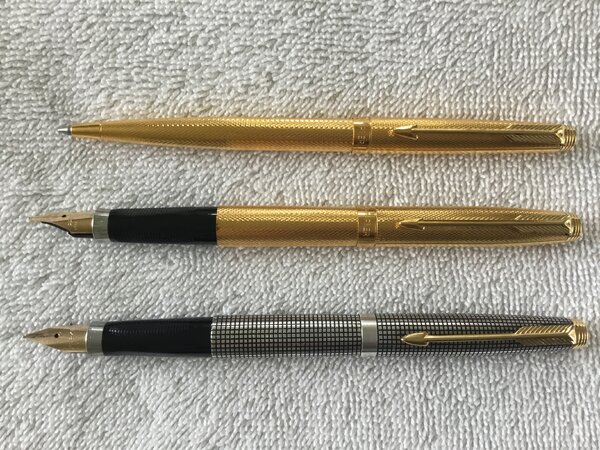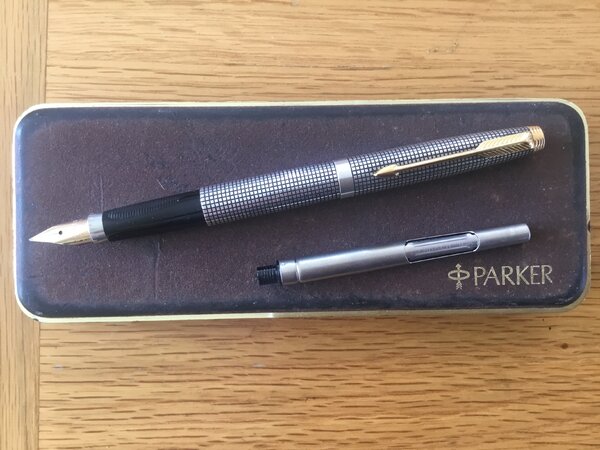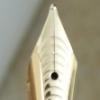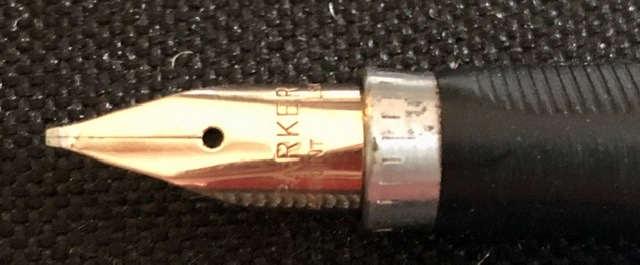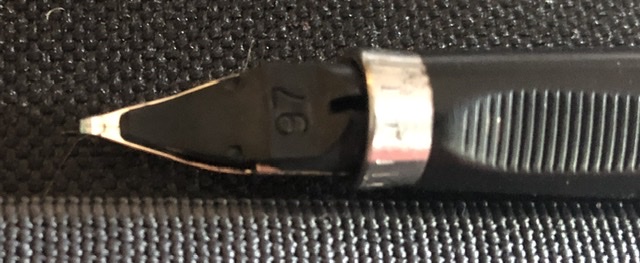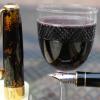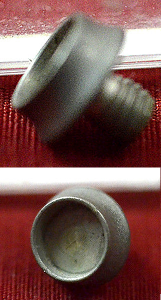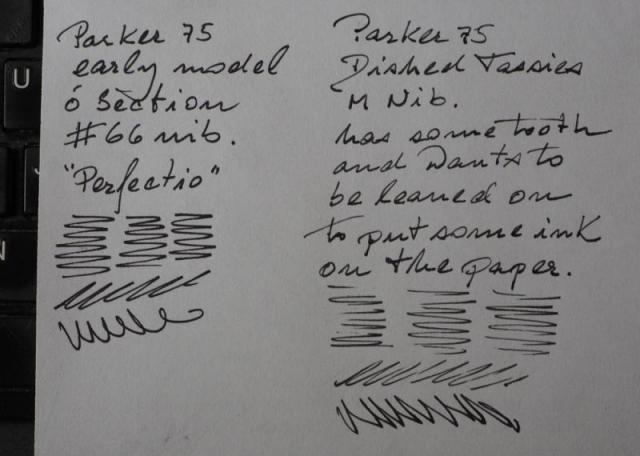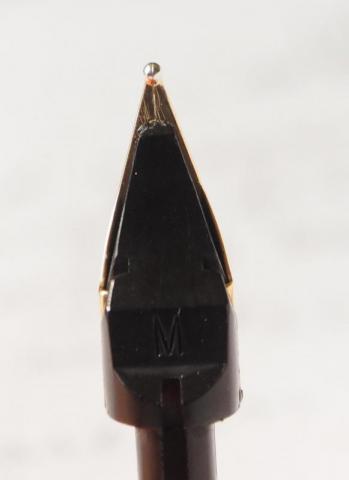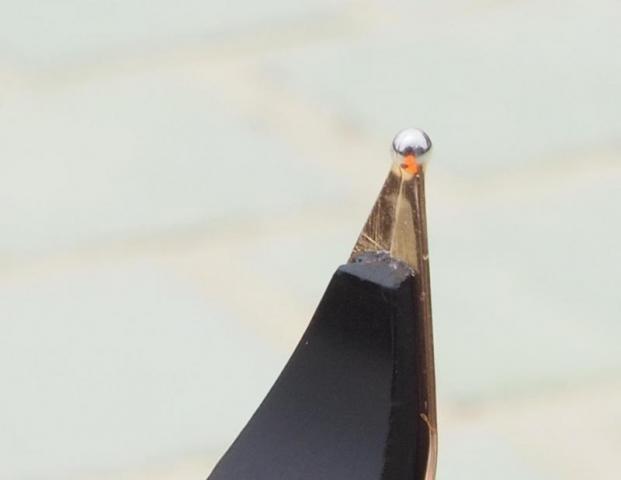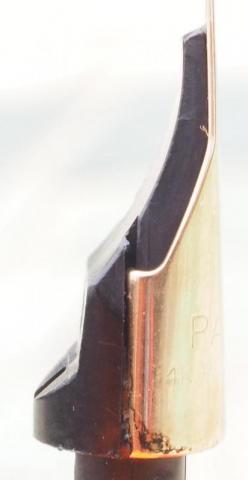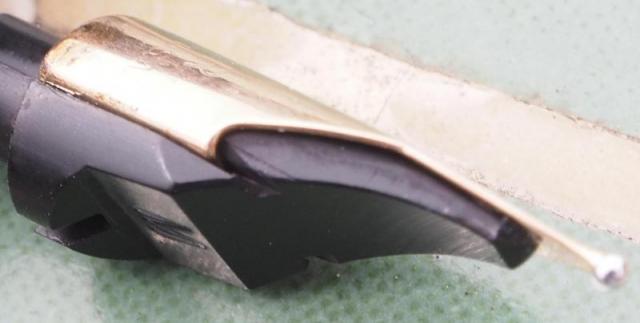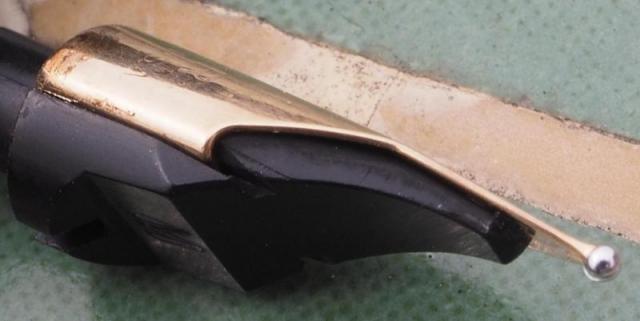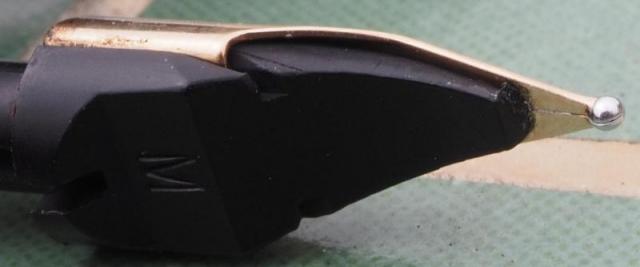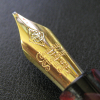Search the Community
Showing results for tags 'parker 75'.
-
Hi, I currently have two Parker 75 pens, and I love them. I am thinking of buying a factory-italic nib to use in them (or perhaps another 75 that has a factory italic nib). My handwriting is rather small, so I am conscious that I won’t be able to use an italic nib if its width is as broad as that of e.g. the ‘fine’ italic nib in the Vector ‘Calligraphy’ set. I expect that only a 75 ‘FI’ or ‘MI’ nib will be narrow enough to suit my cramped handwriting. As replacement 75 nibs are no longer made, they are not cheap. I don’t want to spend a lot of money to buy one, only to then find that it is too wide for me to be able to write with it. So, I would like to ask the FPN ‘Hive Mind’ for any information that you can let me have about these nibs. I don’t expect anyone to be able to measure the nibs’ widths, and then tell me that a ‘Fine Italic’ 75 nib is e.g. 0.34mm wide, or that a ‘Medium Italic’ 75 nib is 0.45mm wide, but I would be very grateful to receive any guidance that you can offer to me. So, would you say that the 75 ‘FI’ nib is ground to a similar width as a ‘normal’ 75 ‘F’ nib? Or perhaps that its grind would be nearer to - or wider than - that of a ‘normal’ 75 ‘M’ nib? Is a 75 ‘MI’ nib ground as wide as the ‘fine’ italic nib in a Vector calligraphy set? Or is it considerably narrower? Can anyone perhaps show me pictures of cross-hatching #### that they have drawn with their ‘FI’ or ‘MI’ nib, alongside comparison cross-hatches that they have drawn with a ‘normal’ 75 ‘F’ or ‘M’ nib, or the ‘normal’ ‘M’ nib of any modern Parker, or the ‘fine’ nib from a Vector ‘calligraphy’ set? My thanks to you in advance! Slàinte, M.
-
First time I've ever seen a gold section ring with a zero mark. On a Parker 75 godron with the old flat ended tassies.
- 2 replies
-
- parker 75
- section ring
-
(and 2 more)
Tagged with:
-
Hi friends, I have always admired the Parker 75 fountain pen and over a period of time, have collected a modest assortment of these in various finishes. However, this one pen was eluding me for quite a while- the Parker 75 Cisele first year model with the metal threaded section. Even a few years back, one could find one listed on eBay occasionally, but no longer the case these days. Seems they have become scarcer, and when they do appear, they are listed at unrealistic and astronomical prices which simply do not justify purchase. Well, recently I have come across a supplier who has the same in mint condition and is asking for USD 300 shipped. Well, it is twice of what a regular model in mint condition and nearly thrice of what a nice user grade pen sells for. I ask for your opinion, my friends, as to the offer I have at hand. Best regards, SS
- 14 replies
-
- parker 75
- parker 75 cisele
- (and 4 more)
-
And I came across this auction which ended a few moments ago, on eBay, where this Parker 75 Florence Sterling Silver FP sold for a whopping $908. I have never come across such a price for a similar model in the past, or perhaps, I need to educate myself more on the desirability of this model...see the link below. https://www.ebay.com/itm/285261661874?mkcid=16&mkevt=1&mkrid=711-127632-2357-0&ssspo=E758IqbyTB6&sssrc=2349624&ssuid=XRhPgKUOTse&var=&widget_ver=artemis&media=WHATS_APP Best SS
- 5 replies
-
- parker 75
- parker 75 florence
- (and 5 more)
-
From the album: OldTravelingShoe's Random Pics of Fountain Pens (2)
© (c) 2022 by OldTravelingShoe. All rights reserved.
- 0 B
- x
-
From the album: OldTravelingShoe's Random Pics of Fountain Pens (2)
© (c) 2022 by OldTravelingShoe. All rights reserved.
- 0 B
- x
-
From the album: OldTravelingShoe's Random Pics of Fountain Pens (2)
© (c) 2022 by OldTravelingShoe. All rights reserved.
- 0 B
- x
-
From the album: Mercian’s pens
I have taken this photo to show an interesting ‘feature’ of my gold-plated 75s in ‘Grain d’Orge’ finish. The ‘dish’ plate at the centre of the cap-tassie of the BP is, like the ‘dish’ plate at the centre of the cap-tassie of the Ciselé Sterling Silver 75 FP, golden in colour. But the ‘dish’ plate at the centre of the cap-tassie of the gold-plated FP is silver in colour. I think that this was done deliberately - that it is not ‘a bug’, but is instead ‘a feature’. Having a different-coloured ‘dish’ plate enables one to easily distinguish one’s FP from one’s BP without having to remove either pen from one’s pocket. L-R: Parker 75 ‘Place Vendôme’ BP, in gold-plated ‘Grain d’Orge’ finish. Made in France. Date code IE (1988 Q3). Bought in a shop in mid-1989, so I am confident about this being its date of production. Parker 75 ‘Place Vendôme’ FP, in gold-plated ‘Grain d’Orge’ finish. Made in France. Date code IE (1984 Q3 or 1988 Q3). Bought through eBay in 2022, so I do not know which of those two dates is the correct one. Parker 75 FP in Sterling Silver Ciselé finish. Made in USA. No date code. But it has ‘dished’ tassies and its ‘Parker’ imprint on cap-band at rear, leaving a blank area under the clip on to which one might get one’s initials/monogram/logo engraved. So, it is a post-1970 pen. And the lack of date codes means pre-1979.
- 0 B
- x
-
From the album: Mercian’s pens
Parker 75 ‘Place Vendôme’ BP, in gold-plated ‘Grain d’Orge’ finish. Made in France. Date code IE (1988 Q3). Bought in a shop in mid-1989, so I am confident about this being its date of production. Parker 75 ‘Place Vendôme’ FP, in gold-plated ‘Grain d’Orge’ finish. Made in France. Date code IE (1984 Q3 or 1988 Q3). Bought through eBay in 2022, so I do not know which of those two dates is the correct one. Parker 75 FP in Sterling Silver Ciselé finish. Made in USA. No date code. But it has ‘dished’ tassies and its ‘Parker’ imprint on cap-band at rear, leaving a blank area under the clip on to which one might get one’s initials/monogram/logo engraved. So, it is a post-1970 pen. And the lack of date codes means pre-1979. With the pens lying in this position, one can easily see the ‘huge’ space that has been left blank on its cap-band underneath the arrow of the clip.
- 0 B
- x
-
From the album: Mercian’s pens
Parker 75 ‘Place Vendôme’ BP, in gold-plated ‘Grain d’Orge’ finish. Made in France. Date code IE (1988 Q3). Bought in a shop in mid-1989, so I am confident about this being its date of production. Parker 75 ‘Place Vendôme’ FP, in gold-plated ‘Grain d’Orge’ finish. Made in France. Date code IE (1984 Q3 or 1988 Q3). Bought through eBay in 2022, so I do not know which of these two dates is the correct one. With the pens lying on their sides one can see the area on the gold-plated pens’ caps that was left blank so that the owner could add engraving. Parker 75 FP in Sterling Silver Ciselé finish. Made in USA. No date code. But it has ‘dished’ tassies and the ‘Parker’ imprint on its cap-band at the rear, leaving a blank area under the clip on to which one might get one’s initials/monogram/logo engraved. So, it is a post-1970 pen. And the lack of date codes means pre-1979.
- 0 B
- x
-
From the album: Mercian’s pens
Parker 75 ‘Place Vendôme’ BP, in gold-plated ‘Grain d’Orge’ finish. Made in France. Date code IE (1988 Q3). Bought in a shop in mid-1989, so I am confident about this being its date of production. Parker 75 ‘Place Vendôme’ FP, in gold-plated ‘Grain d’Orge’ finish. Made in France. Date code IE (1984 Q3 or 1988 Q3). Bought on eBay in 2022, so I do not know which date is correct. Nib is 14k gold, ‘M’, and ‘Made in France’. Parker 75 FP in Sterling Silver Ciselé finish. Made in USA. No date code. But it has ‘dished’ tassies and its ‘Parker’ imprint on cap-band at rear, leaving a blank area under the clip on to which one might get one’s initials/monogram/logo engraved. So, it is a post-1970 pen. And the lack of date codes means pre-1979. This pen’s nib is 14k gold, ‘F’, and ‘Made in USA’. In this photo one can see the ribbed indentations for one’s fingers on the FPs’ grip-sections. The top of the grip-sections in this photo would correspond to a ‘0’ mark on a first-run 75. One can see in this photo how much I have rotated my 75s’ nibs in order to make the writing experience a comfortable one. And it is now a very comfortable writing experience 😊
- 0 B
- x
-
From the album: Mercian’s pens
This Parker 75 was ‘Made in USA’. I think it dates to the late 1970s, but it may be early-1970s (like me). It has a 14k gold ‘F’ nib that was also ‘Made in USA’.
- 0 B
- x
-
Hello! It has been quite some time since I have posted on here. I hope all are doing well. I stumbled upon a GoPens catalog from March 2007 which contained a "1975 Parker 75 “Ecossais” in Black" (item #28). Would anyone browsing this forum happen to know the story behind this pen, and the eventual fate of it? I am interested in any information regarding this seemingly-prototype color/model! I've reached out to the webmaster of GoPens and am awaiting a response, but am afraid that since it has been so long since the listing, they will not have much information regarding it. Regards, Zwomg
-
Difference Between Parker 75 And 180 Ball Pens
thx1138 posted a topic in It Writes, But It Is Not A Fountain Pen ....
As the title says, can anyone please give me some guidance on the difference between Parker 75 and 180 ball pens? They seem almost identical. I'm sure there must be some difference but I cant really find one other than some of the 180 ball pens have smooth tassies. -
This is a Parker 75 medium stub ciselé of around 1968-1971. Writing sample: The line thickness it produces is about 0.9 mm in width. This width is comfortable for writing characters of medium size (see also the writing comparison). The pen’s triangular section is thin, but it is very comfortable to hold. The pen as a whole is on the smaller side, but the nib is big. Since the pen is of some vintage it is a stub proper rather than cursive italic, i.e. the tipping is noticeably thick with the writing edge noticeably but not drastically rounded (see schematic). The side edges are not rounded so as to be visible with the naked eye; the Artpen is also like that whereas the bottom of the Dostoevsky’s tipping has no corners but only smooth curves. It will not tear paper however. All three pens are extremely forgiving with the Artpen being the one most able to be held entirely carefree as if it did not have a broad edge. The 75’s stub nib does not like very much smooth paper, either of the good (Rhodia) or of the cheaper (many modern notepads) variety. On Rhodia the 75 stub flies off the paper surface, often leaving no ink behind. Skipping on downstrokes is usual when writing at my usual speed, which is rather fast. By comparison, the Artpen iceskates on Rhodia leaving a thin film on ink behind and the Dostoevsky swims in its own ink. On school notebooks and on paper with cotton content the stub 75 performs consistently without problems and is definitely wet (the Dostoevsky and the Duofold are wetter, as can be seen on the comparison sheet). Some closeups of the nib: The pen feels light but with a perceptible substance in the hand. Overall, this is a gorgeous pen allowing some very expressive writing.
-

Just Discovered A Parker 75 With 14K Fine Italic Nib
bbbdco posted a topic in Fountain & Dip Pens - First Stop
With the current COVID-19 crisis, I have been spending a lot of time at home. I have rediscovered all my old calligraphy pens and have been relearning the art of fine writing. I was still missing a few items, and I came across an old box in my basement. I found several old items of ink, nibs, etc. In one of the boxes I found my old Parker 75 14k fine italic fountain pen. I remember purchasing it about 1985. So it is 35 years old. It was hardly used as it had the original cartridge still in the barrel. I hoped that the pen was not ruined because it had been left with the ink inside. I spent about an hour cleaning it up. Removed the nib and feeder, then pit it back together. I re-inked the pen and it works like a charm. I dont know how much these things are worth today, but I did a quick check on my particular nib, and a new old nib would cost $125. I remember spending $50 for the pen in 1985, a lot of money for me back then. Anyway I was just excited to find this old treasure in my basement. I am including a few images of the pen. The pen itself is extremely slim and quite small. It has to be posted in order to use it. Any interesting comments about the Parker 75 would be appreciated. -
To the point: any advice before I start using a Parker 75 bought used? One with the thinner section, fine size nib. Longer story: I'd given up on the 75 given that I have no way of trying them in person, and they are apparently thinner than Sonnets, of which I have two. But... I came across one for a low price, which seemed in good nick, and in the design that intrigued me the most, milleraies (yes, ciselé looks awesome too). So... Instead of wisely saving for the one pen missing in my collection, a Waterman Carène, there I go blowing the budget... Which was already seriously dented by a Pelikan m205 and a couple of Lamy Studios... Soooo... This might take a while to get to me, but since it's a used pen, what would you recommend? 1. Dunk the section overnight, nib and all in water before anything else, to loosen any dried ink? 2. Try to remove the nib and feed first, by pulling it out, and cleaning them separately? It pulls out straight? This is what I would do with most of my pens, but I don't want to break anything. I did break a feed inside a Sonnet section, probably my fountain pen low point. 3. I understand the nib and feed are not easy to disassemble so better leave them well alone? 4. Very specific info: are these pens rather dry or rather wet? I am very particular about how inks come out, so for instance Ama Iro and Ajisai looked terrible (to me) on most (wet) pens, look consistently great with EF Studios, while Tsuyu Kusa really came into its own with a wet Professional Gear. I will definitely stay away from difficult inks which leave crud or sediments, like Rouge Hematite or Équinoxe 6; if you're happy or unhappy with the ink in your 75, please tell me about it. 5. I think this is silver coated? How does one clean that, if needed? 6. Will a modern Pelikan Parker converter work fine with these? Any other tips? Hopefully it won't be too thin for my L glove sized hands, otherwise... I suppose I'd have to give it away, and I'll probably never hear the end of it. Thanks in advance!
- 33 replies
-
- parker 75
- milleraies
-
(and 3 more)
Tagged with:
-
I have just inherited my father's Parker 75, a sterling silver ciselé which the Parker Penography website says started being offered in 1966. It has a few battle-scars and needs a seriously good clean but appears to be in good condition, except for one thing. The pen won't insert into the cap. I looked into the cap under illumination and one or perhaps two of the arms of the inner cap (is this called the inner cap clutch?) are bent and sticking out. There are replacements advertised on ebay, and one of them is winging its way to me - but I can find no information about the best way to get the old one out, and replace it with the new one. All help gratefully received. Peter
-

Fixing A Parker 75 Bicentennial (Aka "i Might Be In Over My Head")
alexwi posted a topic in Repair Q&A
Hi, I got a Parker 75 Bicentennial whose cap jiggles. Don't know if that's the right term, but when capped, the cap doesn't stay in place, and it moves up and down about half a millimeter. The issue is the inner plastic cap, which needs to be replaced, as the cap behaves the same when I put it on another 75, and other 75 caps work perfectly with the Bicentennial. My problem lies in disassembling the cap. With regular tassies, that's not a big deal, because the tassies are solid, so it's not difficult to get a good grip on them and start turning the cap. This pen, however, has a hollow tassie, and to make things even more fun (the euphemism of the year), they're made of very soft pewter (see picture). As it is, attempt #1 already resulted in a slightly deformed and, even worse, marred tassie. Does anyone have any suggestions regarding WHAT to grab the tassie in a way that I'll have enough friction and not ruin the tassie? If it's something I can pick up at home depot that might serve this purpose, even better. I'll take care of the marring I already caused with a burring tool and will then figure out how to deal with the slight deformation, but one step at a time - I have be first be able to remove the darn thing first. Also, since, as I said, this might be more than I can chew, can I get recommendations on who to send the pen to in case I determine that this is more than I can do? Thanks all and happy thanksgiving! Alex- 8 replies
-
- parker 75
- parker 75 cap
- (and 3 more)
-
The Parker 75 “Cisele” & Sheaffer Silver Imperial
SimiaeParvus posted a topic in Fountain Pen Reviews
The Parker 75 “Cisele” & Sheaffer Silver Imperial After a few years in the hobby of collecting fountain pens I’ve reached a point, where my acquisition of pens gravitates towards a preferred style of pens. After some deliberation, I´ve come to the long term goal of acquiring a pen in sterling silver from each the “Big Four” American companies: Parker, Sheaffer, (Wahl-) Eversharp and Waterman. I´m currently halfway to that objective, having hunted down a Parker 75 in the “Cisele” (or “Cicelé”) pattern and a Sheaffer Silver Imperial in a diamond pattern. There’s no doubt that both represent the top-of-the-line in terms of design and materials. Aesthetically, they both share similar characteristics, being sterling silver pens sporting gold trim and a distinctive pattern engraved into the body of the pen. The Parker 75, released in the early 1960´s was a hit on the market. Since the ballpoints increase popularity and the eventual decline of the fountain pen, the purpose of the 75 was to be one of revival and prestige. The pen was aesthetically innovative attempt to catch the higher end. Earlier, Parker had tried to appeal to the broader market with pens such as the 21, 41 and 45 which was in the low end range.The 75 borrows design elements several other lines of Parkers pens. The idea of an adjustable nib had been tossed around since 1962 VP´s user-adjustable nib and the cartridge-converter was borrowed from the Parker "45". The Parker 75 Sterling Cisele hit the market in 1964, although being finished in 1963 for Parkers 75th anniversary. Decades later, the design is still as eye catching as when it was released and the quality shines through. It follows the basic design of the 75, which haven´t changed in decades. It´s a classy, conservative design that has aged well. Where it differs, is that the body of the pen is made of sterling silver, with a grid pattern. The body of the pen is rather slim, tapering from 11mm to 8mm. The cap is a “slip-on” which is solidly seated and post well. Because of it´s size and weight, posting is probably needed. The clip is simple but very distinctive and the details are simply beautiful. The tassies at either end is applied and is most likely gold plated. The black plastic section has a triangle-shaped grip and the nib can be rotated to different angles. That helps users which grip tend to rotate the pen. The upper part of the of the section, has several indices designating how much the nib is rotated. On earlier versions a “0” marked the center, but that was discontinued in 1968. Lacking that, this is probably made post-1968, just a few years before the introduction of the Sheaffer Silver Imperial. The nib is It writes really well, though it´s slightly dry and runs a nib gauge finer than the designated medium. The filling system is the simple and reliable cartridge-converter system. This system has been covered extensively elsewhere, so I won´t go over it here. Sheaffer did what any competitor would do. After the success of the Parker 75 they attempted to gain some of the market share, a few years later. The pen follows the design of the Imperial series, but instead of the typical it´s sterling silver in a lively diamond pattern. The pen is a classical, robust cigar shape with flat tops. It transitions with a slight taper from 12mm at the center of the barrel to 9 mm at either end. The body of the pen, is unibody with no particular step down from the cap. particularly the tapering section reminiscent to the Parker “51”. The shape of the body/section allow a variety of grips, which allows best writing angle for a wider group of users. The cap is a slip-on (“snap-cap”) is held on by friction. To keep it in place, there is three small tabs on the section, just between the section and barrel. It stays in place quite well, but doesn´t quite “click”. It can be posted, but I would not recommend it, as it throws off the balance and mar the finish. The gold filled clip has the white dot, indicating the lifetime guarantee. The clip is rather flat in colour, and seems slightly out of place. It is also is quite stiff. It seems poorly attached to the cap, so if you play with the clip a lot, be aware that it might snap off entirely with little to no force. The Touchdown filling system was introduced by Sheaffer in 1949, and is quite unique. It utilizes pneumatic air pressure created by down stroke of a cylindrical plunger to compress the sac inside the cylinder and fill the pen. For a proper fill, the entire nib and section must be immersed in the ink. Albeit for its innovativeness the Touchdown takes some getting used to, at it is slightly finicky. The system is quick to fill once you have the hang of it, but very slow to clean out. If you are a serial ink sampler, this might become slightly infuriating. But, if you like me, stick to the same inks it won´t be a problem if you stick to the same ink and the occasional maintenance cleaning. According to the sources, the pen is also available as a cartridge-converter, which should solve this disadvantage. Then there is Sheaffers infamous inlaid nib, unique to Sheaffer. Aesthetically, the design compliments the diamond pattern of the body quite well and is certainly anything but traditional. I suspect, although this is unfounded (I have done no work on this particular style of nib), that adjusting the nib shouldn´t be much trouble compared to a “standard-shaped” nib. Replacing it would another case though! The nib is where this pen really shines though: It´s a smooth experience with a slight bounce to it and the ink flow is almost perfect. Because of its wet nature, it runs slightly wider than the designated medium, bordering on a broad. In comparison, the 75 and Imperial are, albeit their similar aesthetics, quite different animals. Both pens have looks and the weight is pleasantly substantial because of the materials used, but where the 75 is slender and conservatively elegant, the Silver Imperial is slightly more hefty and bolder/flamboyant in its expression. In terms of construction, the Parker comes out slightly ahead, as the clip doesn´t seem as brittle and the Cartridge-Converter is more reliable in terms of use, maintenance and longevity. I´m aware that Silver Imperial is available in an C/C-incarnation, which nullifies this disadvantage. The diminutive size of the 75 and the forced tripod grip is too narrow for writing for more than a few minutes at a time before my hands cramp. The outcome is, a matter of preference. The Parker 75 isn´t quite as finicky or high maintenance as the Silver Imperial but the narrow, triangular grip is a minor but deciding gripe (No pun intended) for me although the adjustable nib angle a clear advantage as I have a tendency to rotate the pen. Parker 75 “Cisele”/ “Cicelé”, USA Production period: 1964-1966 Material: Sterling Silver in a crosshatch, cisele pattern Nib: 14k Medium Filling System: Cartridge-Converter Appointments: Gold Plated Length (Capped): 133mm Length (Uncapped): 122 mm Section Diameter: 9 mm Barrel Max Diameter: 11 mm Cap Max Diameter: 11 mm Weight, Uncapped (with ink and/or converter): 15 g Weight, Capped (with ink and/or converter): 24g Sheaffer Silver Imperial, USA Production period: 1970-197 Material: Sterling Silver in a crosshatch, diamond pattern. Nib: 14k Medium Filling System: Touchdown Appointments: Gold filled Length (Capped): 142 mm Length (Uncapped): 124 mm Section Diameter: 11 mm Barrel Max Diameter: 12 mm Cap Max Diameter: 12 mm Weight, Uncapped (with ink and/or converter): 18 g Weight, Capped (with ink and/or converter): 27 g Sources: Fischier. ”Parker 75”. www.Parkerpens.net. Web. 18.08-2018. <https://parkerpens.net/parker75.html> Mamoulides. “Sheaffer Touchdown Filling System”. www.Penhero.com. Web. 18.08-2018. <http://www.penhero.com/PenGallery/Sheaffer/SheafferTouchdownGuide.htm> Thomas. ”The Sheaffer Imperial Family of Fountain Pens”. www.Sheaffertarga.com. Web. 18.08-2018 <http://www.sheaffertarga.com/imperial%20and%20triumph/imperial%20write%20up.html> Wong. “FAQ”. www.Parker75.com. Web. 18.08-2018. <http://www.parker75.com/FAQ/FAQ.htm>- 8 replies
-
- parker 75 “cisele”
- sheaffer silver imperial
- (and 4 more)
-
Hi, I just got a Parker 75 with a Medium nib, possibly 1970's, as the nib's marked with a letter and the tassies are dished, but it's incredibly dry (see sample). I already left the nib and the section soaking all night (not much came out), and then a few hours this morning, in warm water with a drop of dishwashing soap. There was some serious muck under the nib (at the tip of the feed), which I used an exacto knife to remove - you can see some of it in the photos, and there's also some in the slots where the nib slides into the feed. After the two soaks, it's somewhat better, but writing with this pen is still anything but pleasant. I suspect there's more dried ink between the nib and the feed, but I can't get to it unless I take the assembly apart. I've disassembled this kind of nib before. It took a bit of coaxing, but it was doable. This one, however, isn't budging one bit and, of course, I don't want to break anything, so I'm curbing my super-powers for now. I still have to try 10% ammonia, but that'll have to wait until I'm back home tonight, as I don't want to do that for more than an hour at a time (unless some learned expert considers that it's OK to leave it for longer periods - and how long, btw). Does anyone have any ideas or suggestions on how to remove the nib from the feed? Thanks! Alex
-
A friend of mine gave me this wonderful Parker 75, last month. It served him well for years, but he's never been a fountain pen enthusiast, so he never cleaned it. As I received it I washed it all thoroughly, except for the probably most clogged part: under the nib (pic related) Do you know how can I slide off the nib? It seems impossible. Now onto the main topic of this thread. The pen has always been used with cartridges and, under the stress of pulling them out as they emptied, the mating nipple completely broke. Parker was not able to repair it as that section was not being produced anymore, so that's not an option. I'd really love to bring this beautiful pen back to life, so I thought that I could 3d print a nipple and glue it inside the section. Do you think it would work? Do you have any advice about the material/process I should adopt? Thanks in advance
- 17 replies
-
- parker 75
- broken nipple
-
(and 1 more)
Tagged with:
-
One of my earliest memories of pens being special and valued was a Parker ballpoint and pencil set my grandfather used to wear in his shirt pocket. I always thought they were special and I guess I coveted a set like that for my very own. He had them for many years, but they seem to have been lost during a move in the 90's sometime. So I don't have them now as a memento, but I remember them clearly and always associate that pen and pencil with him. Fast forward many years and I'm poking around on pen sites and there is the same pen that my grandfather had! Turns out it was a Parker 75 Sterling Silver Cisele (not sure if they used that term back then but that's what is known as now). His set was probably from late 60's or early 70's, but I know it was years prior to 1976. Being a lover of fountain pens and wanting something that reminds me of him, I'm looking for a late 60's Parker 75 Sterling Silver Crosshatch (or Cisele) fountain pen, not ballpoint. I have no experience with vintage pens except for a few Parker 21's and 51's I inherited from my father, so I'm looking for advice on any gotchas associated with Parker 75, things to look out for, where might be a good place to start looking, etc. And I'd like to avoid eBay, not my favorite place and I'm too inexperienced to spot fakes. Are there many fake P75's floating around or is that slanted more to the P51 and Montblanc areas? So any good, reputable dealers you would recommend? Price isn't really an issue as long as it's reasonable for the individual pen. I'm more concerned with integrity and friendly service. If you have one, how does it feel in the hand? Would you say it's a good or bad pen? Again, not so much concerned with the specific nib, I can always get that adjusted as long as it's in decent shape. What about the filling system, C/C yes? Any idea on capacity? Does the cap seal well, even on older or well-loved pens? Something along like this, or maybe the Premier version: http://www.carmenriverapens.com/wp-content/uploads/parker-cisele-sterling-silver-crosshatch-fountain-pen-2-e1394133584573.jpg (shameless lifted from Carmen Rivera Pens...) Thanks for your help.
-
Photo:
-

